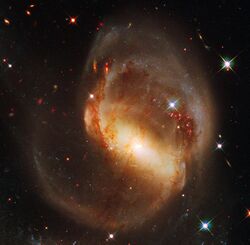Astronomy:NGC 7319
| NGC 7319 | |
|---|---|
 NGC 7319 imaged by the Hubble Space Telescope | |
| Observation data (J2000 epoch) | |
| Constellation | Pegasus |
| Right ascension | 22h 36m 03.56s[1] |
| Declination | +33° 58′ 32.7″[1] |
| Redshift | 0.022[1] |
| Helio radial velocity | 6,740 km/s[2] |
| Distance | 311 Mly (95.3 Mpc)[1] |
| Apparent magnitude (V) | 14.1[3] |
| Characteristics | |
| Type | SB(s)bc pec[3] |
| Apparent size (V) | 1′.7 × 1′.3[3] |
| Other designations | |
| NGC 7319, UGC 12102, PGC 69269[4][3] | |
NGC 7319 is a highly distorted barred spiral galaxy that is a member of the compact Stephan's Quintet[5] group located in the constellation Pegasus, some 311 megalight-years distant from the Milky Way.[1] The galaxy's arms, dust and gas have been highly disturbed as a result of the interaction with the other members of the Quintet. Nearly all of the neutral hydrogen has been stripped from this galaxy, most likely as a result of a collision with NGC 7320c some 100 million years ago.[6] A pair of long, parallel tidal tails extend southward from NGC 7319 in the direction of NGC 7320c, and is undergoing star formation.[7]
This is a type 2 Seyfert galaxy[1] with one of the largest circumnuclear outflows known in galaxies of this type. This outflow reaches velocities of up to 500 km/s and spans 13 kly. The star formation rate appears normal for a spiral galaxy at 1.98±0.58 M☉ yr−1, and the majority (68%) is occurring in the spiral arms.[7] The core appears faint in the ultraviolet band, indicating heavy extinction within the active galactic nucleus.[7] There is a three component radio source with an overall size of 5.5 kly that is straddling the nucleus.[8] A strong X-ray source with a high redshift has been detected at a separation of 8″ from the galactic nucleus. This quasi-stellar object is most likely being ejected from the host galaxy.[2]
One supernova has been observed in NGC 7319: On 19 August 1971, Leonida Rosino discovered SN 1971P (type unknown, mag. 16.8).[9]
References
- ↑ Jump up to: 1.0 1.1 1.2 1.3 1.4 1.5 Koss, Michael et al. (October 2011). "Host Galaxy Properties of the Swift Bat Ultra Hard X-Ray Selected Active Galactic Nucleus". The Astrophysical Journal 739 (2): 20. doi:10.1088/0004-637X/739/2/57. 57. Bibcode: 2011ApJ...739...57K.
- ↑ Jump up to: 2.0 2.1 Galianni, Pasquale et al. (February 2005). "The Discovery of a High-Redshift X-Ray-Emitting QSO Very Close to the Nucleus of NGC 7319". The Astrophysical Journal 620 (1): 88–94. doi:10.1086/426886. Bibcode: 2005ApJ...620...88G.
- ↑ Jump up to: 3.0 3.1 3.2 3.3 "NASA/IPAC Extragalactic Database". Results for NGC 7319. http://nedwww.ipac.caltech.edu/.
- ↑ "NGC 7319". SIMBAD. Centre de données astronomiques de Strasbourg. http://simbad.u-strasbg.fr/simbad/sim-basic?Ident=NGC+7319.
- ↑ Di Mille, F.; Ciroi, S.; Rafanelli, P.; Moiseev, A. V.; Smirnova, A.; Afanasiev, V. L.; Dodonov, S. N. (October 2008). "3D Spectroscopy of the Nuclear Environment of a Selected Sample of Nearby Active Galactic Nuclei: NGC 7319". in Funes, José G.; J., S.; Corsini, Enrico Maria. Formation and Evolution of Galaxy Disks. Proceedings of the conference held 1–5 October 2007 at the Centro Convegni Matteo Ricci, Rome, Italy. 396. San Francisco: Astronomical Society of the Pacific. p. 61. Bibcode: 2008ASPC..396...61D.
- ↑ Moles, M. et al. (August 1997). "The Dynamical Status of Stephan's Quintet". The Astrophysical Journal 485 (2): L69–L73. doi:10.1086/310817. Bibcode: 1997ApJ...485L..69M.
- ↑ Jump up to: 7.0 7.1 7.2 Xu, C. Kevin et al. (January 2005). "Ultraviolet Emission and Star Formation in Stephan's Quintet". The Astrophysical Journal 619 (1): L95–L98. doi:10.1086/425130. Bibcode: 2005ApJ...619L..95X.
- ↑ Aoki, Kentaro et al. (August 1999). "The Radio Emission of the Seyfert Galaxy NGC 7319". The Astrophysical Journal 521 (2): 565–571. doi:10.1086/307559. Bibcode: 1999ApJ...521..565A.
- ↑ Transient Name Server entry for SN 1971P. Retrieved 25 March 2023.
External links
- NGC 7319 on WikiSky: DSS2, SDSS, GALEX, IRAS, Hydrogen α, X-Ray, Astrophoto, Sky Map, Articles and images
Coordinates: ![]() 22h 36m 3.5s, +33° 58′ 33″
22h 36m 3.5s, +33° 58′ 33″
 |

